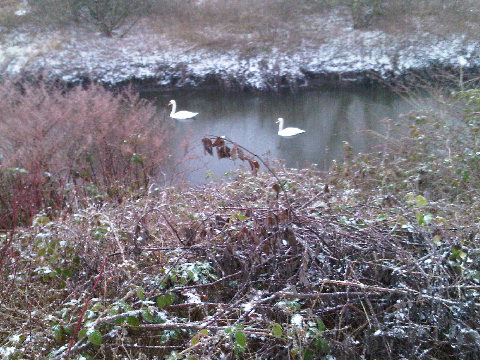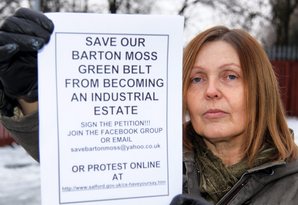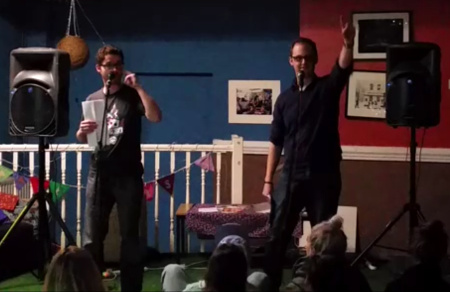Protected species endangered by building on Green Belt in Salford say campaigners
Article published: Wednesday, January 6th 2010
The future of a strip of Green Belt land in Salford is being threatened by an industrial development plan proposed by Salford City Council. The development could also menace the existence of a number of endangered bird species.
 As part of its draft Core Strategy, the Council is proposing that 98 acres of land at Barton Moss, which includes Grade 1 agricultural terrain and an 18 hole golf course, should be turned over to developers for the use of new industry and warehousing.
As part of its draft Core Strategy, the Council is proposing that 98 acres of land at Barton Moss, which includes Grade 1 agricultural terrain and an 18 hole golf course, should be turned over to developers for the use of new industry and warehousing.
However, those opposed to the development say such an interference with the green space would have detrimental ecological effects. The land in question is based on peat bog and is home to species of endangered birds such as barn owls, other listed species including kestrels, yellow wagtails and peregrine falcons have been sighted on Barton Moss in the last five years.
Jackie Anderson of Eccles has started a petition which has so far collected 1,000 signatures against the proposal.
“The traffic, pollution and shocking use of green belt in this area would have an impossible effect on life not only for those living in Salford but the rest of Manchester as the traffic on the M60 would be at a continual standstill.
“Salford Council say that to compensate for loss of greenbelt in Irlam, they will create more green belt on a site on Little Hullton. However, this proposed site in Little Hulton is actually a disused mine site and it is not a viable option.”
The Council argue that it is vital to build the warehousing on the green belt land as it is one of the only sources of land which can be exploited to create employment opportunities in the City, which has one of the highest rates of unemployment in the UK.
Yet opponents counter that the real reason for this decision is that the warehouses will service the Port Salford development, owned by regional giant Peel Holdings, which lies directly opposite. This will link Manchester Ship Canal to the highest capacity rail terminal in Britain and many think the decision is being taken in Peel’s commercial interest rather than those of citizens in the area. Some residents have asked why other sites, such as the disused land on the opposite side of the canal in Trafford cannot be used for building warehouses, while adding that as it is based on reclaimed bog and ex-landfill, Barton Moss is not a suitable choice for heavy industry and heavy use train lines.
Others have voiced concern about the levels of noise and disturbance that the railway, which will carry the longest trains in Britain – up to 750m in length – and to be used 24 hours, will cause residents in the area, since the development will be situated in close proximity to family homes.
Further complaints have been made in relation to the lack of adequate road infrastructure to accommodate the developments, and there is fear that the construction of any new industrial and warehousing spaces would cause further congestion to nearby roads and motorways.
In addition to the proposals for Barton Moss there are other proposed developments across the area which are coming under flak for the threat they pose to green areas. Peel are known to be keen to construct Salford Forest Park in Worsley, to be comprised of recreational facilities and a race course, on a 400 acre plot of green belt land.
 Mrs Anderson believes there is now a common thread that unites the campaigns and believe that they should link up to strengthen their common cause.
Mrs Anderson believes there is now a common thread that unites the campaigns and believe that they should link up to strengthen their common cause.
“Initially when we started the Barton Moss Green Belt protest 4 weeks ago, this was our main and only focus. Since reading the core strategy in more detail, we also wish to object to other elements of the strategy including the building of the Salford Forest Park and racecourse, the using of green belt land in Cutacre near Little Hulton and various requests to build houses all over the green belt on the Moss.”
The plans have even come under attack from local MP Barbara Keeley who says that any move to destroy the wildlife haven would actually contradict the Council’s own policy document, ‘Nature, Conservation and Biodiversity’, which pledges to protect such species.
Meanwhile Mrs Anderson is appealing to Salford City Council to introduce positive development measures that will benefit both residents and the local economy in a sustainable way.
“Salford Council must follow Manchester Council’s lead and revise its Core Strategy to have a greener and truly more sustainable focus including creating green jobs from retrofitting social housing and finding alternative green energy rather than creating more industrial waste sites.”
However, it is worth recalling that Manchester City Council, for all its triumphantly paraded visions of sustainability and conservation, has so far shown its pledge to be a promise largely unkept – evidenced by recent decisions to hand over popular green spaces and destroy areas of extreme ecological importance.
Mrs Anderson is calling for a referendum to decide the matter.
Michael Pooler
A public meeting will be held tonight at 7 pm on Wednesday 6 January 2010, at Higher Irlam Social Club, Cutnook Lane, Irlam to discuss the proposals and progress of the petition. The petition needs to be signed and submitted to Salford City Council by 15 January 2010.
More: Manchester, News
Comments
-
Another problem with building on peat is the release of tonnes of CO2 which has been stored in the peat for 1,000 years. But like aviation emissions this will not counted in the nations overall CO2 footprint. So much for a green government.
Comment by Patrick Sudlow on February 25, 2010 at 5:32 pm
The comments are closed.



